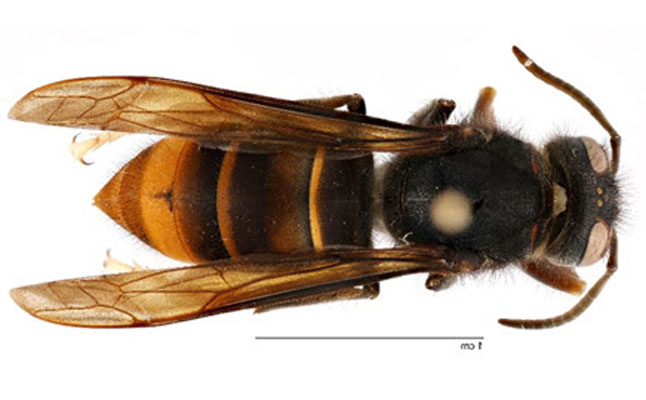
PHOTO: GDA
The Georgia Department of Agriculture (GDA), in coordination with the U.S. Department of Agriculture Animal and Plant Health Inspection Service (USDA APHIS) and the University of Georgia (UGA), confirmed the presence of a yellow-legged hornet, Vespa velutina, near Savannah, Ga., in August 2023.
This is the first time a live specimen of this species has been detected in the United States.
The yellow-legged hornet poses a threat to honeybees and other pollinators in Georgia. These pollinators play a significant role in Georgia’s agriculture industry, the state’s main economic driver, and it is imperative these invasive pests are tracked and eradicated. GDA is working with the USDA APHIS and UGA to trap, track and eradicate these pests. It will continue to assess the situation as new information becomes available and allocate additional resources as need.
The public plays an important role, and the GDA is asking Georgians to report sightings of the yellow-legged hornet using this online reporting form.
According to the website, the GDA urges “the public to be cautious in the event they come across a suspected yellow-legged hornet. If you can safely take a photo of the suspected yellow-legged hornet, we encourage you to do so to assist us with identification.”
GDA also told Pest Management Professional (PMP),”The Georgia Department of Agriculture (GDA) is asking pest management professionals to report suspected sightings of the yellow-legged hornet to their local extension agency or Department of Agriculture. As with our pest management needs, GDA recommends that consumers hire a licensed pest management professional to address pest management issues like a hornet nest on or near a home/building. Pest management professionals can apply an EPA-registered pesticide for hornets and must follow the pesticide label directions.”
About the Yellow-Legged Hornet
A native to tropical and subtropical areas of Southeast Asia, the yellow-legged hornet is generally smaller than the Northern Giant Hornet (NGH).
Workers can be around half the size of an NGH, and queens can be around three-fourths the size. The legs are partially or primarily yellow, hence the common name “yellow-legged hornet.” The body and head coloration can vary. This hornet is a social wasp species that constructs egg-shaped paper nests above the ground, often in trees. These nests can become large, housing an average of 6,000 workers.
The yellow-legged hornet feeds on a variety of insects. If allowed to establish in the U.S., this invasive species could threaten honey production and Georgia’s native pollinators. These native pollinators play a vital role in Georgia’s agriculture industry.
A statement to PMP from the National Pest Management Association (NPMA) shared, “The NPMA urges pest management professionals (PMPs) to be on the lookout for the yellow-legged hornet when responding to arboreal hornet service calls and encourages members to report sightings along with photo evidence to the GDA.”
PMPs who believe they have seen a yellow-legged hornet in their area should complete this online reporting form after reviewing the information above. If it is safe to do so, submit a picture and other details about any suspected sightings of the yellow-legged hornet. Photographs allow the GDA to verify the identification, which is important since some native wasps can look very similar. If you are unsure about your specimen, please send a picture anyway.
Leave A Comment